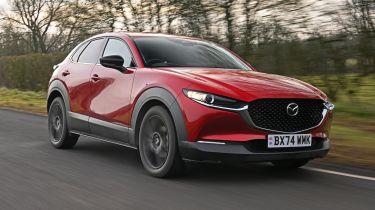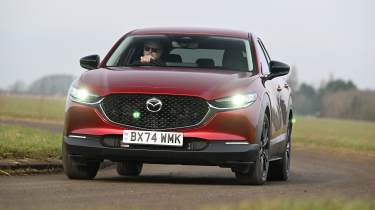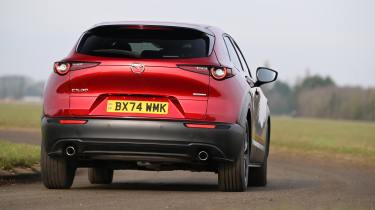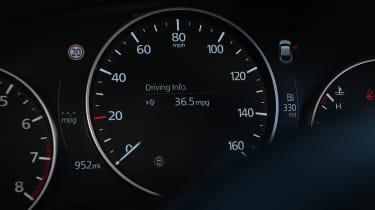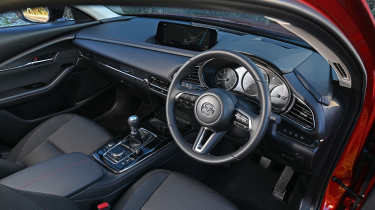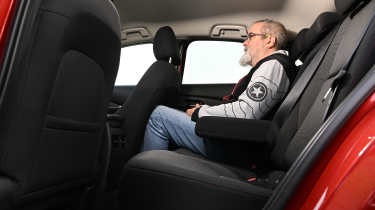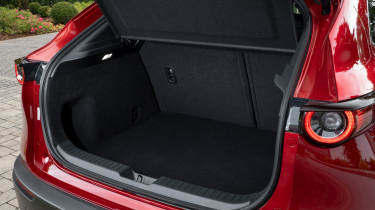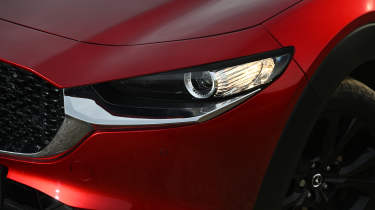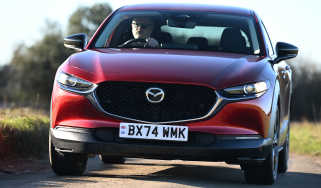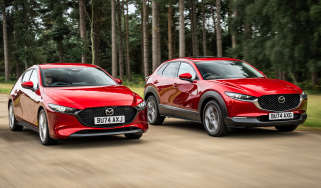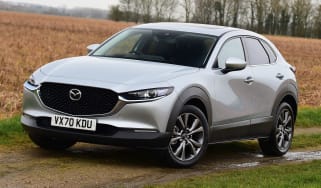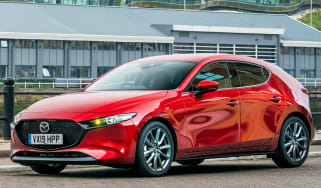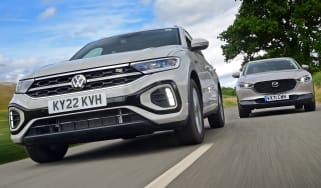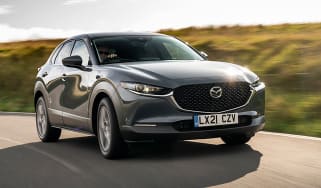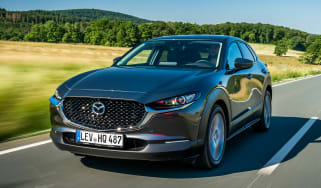Mazda CX-30 review
Mazda’s smallest SUV is fun, safe and boosted by extra power and torque from a bigger engine

Our opinion on the Mazda CX-30
We’re big fans of the Mazda CX-30 because it’s one of the few small SUVs on the market that’s actually enjoyable to drive, with a sporty feel that is lacking from many of the alternatives options in the class.
The CX-30 also offers a premium cabin that goes some way to justifying its pricing, and while the engine line-up is limited to just two options, they’re both good to use and offer decent performance, although fuel economy isn’t quite on a par with the most efficient turbocharged petrol alternatives. It’s not the roomiest small SUV on the market, but the positives listed above help to make up for that.
|
Key specs | |
| Fuel type | Petrol |
| Body style | Five-door, five seat small SUV |
| Powertrain |
2.0-litre 4cyl petrol mild hybrid, front-wheel drive 2.0-litre 4cyl petrol mild hybrid, four-wheel drive 2.5-litre 4cyl petrol mild hybrid, front-wheel drive |
| Safety | Five-star Euro NCAP (2019) |
| Warranty | Three years/60,000 miles |
About the Mazda CX-30
While the Mazda CX-30 is the company’s smallest SUV, in terms of the new-car market in general, it actually falls between classes. It’s based on the same platform as the Mazda 3 family hatchback, whereas some of its rivals use platforms sourced from smaller machines that rival the Mazda 2 supermini. It doesn’t have a high-riding stance like the larger Mazda CX-5 SUV, either, and is more like a crossover in terms of its proportions.
Since it first arrived in 2019, we’ve tested several variants of the Mazda CX-30 on UK roads. We’ve also had a CX-30 Homura in our long-term fleet, in order to truly find out what this small SUV is like to live with every day. While it wasn’t without its shortcomings in areas such as practicality, our testers couldn’t help but be charmed by this car’s driving experience and upmarket interior.
Mazda CX-30 prices and latest deals
Prices for the CX-30 start from around £26,500 and extend to £32,000. There are five trim levels.
Used - available now

2025 Mazda
Cx-30
11,959 milesAutomaticPetrol2.0L
Cash £21,691
2020 Mazda
Cx-30
25,190 milesAutomaticPetrol2.0L
Cash £14,499
2022 Mazda
Cx-30
16,590 milesAutomaticPetrol2.0L
Cash £19,299
2020 Mazda
Cx-30
20,980 milesManualPetrol2.0L
Cash £15,100- Prime-Line
- Centre-Line
- Homura
- Exclusive-Line
- Takumi
It’s worth noting that Mazda’s Skyactiv X engine isn’t fitted to Prime-Line or Centre-Line cars, so for that you’ll need to move up to the mid-range Homura at least.
You can build your perfect Mazda CX-30 through the Auto Express Buy a Car service. We also have plenty of new Mazda CX-30s in stock, as well as top used Mazda CX-30 deals. We can also help you sell your car.
Performance & driving experience
| Pros |
|
| Cons |
|
The CX-30 is relatively low-slung for an SUV, and its driving manners are more akin to a hatchback than a high-riding 4x4.
Mazda has always gone its own way with engineering, so while the majority of rival firms have embraced turbocharged petrol engines for a balance between performance and efficiency, the Japanese firm has stuck with natural aspiration.
But the Skyactiv X engine at the top of the range features some clever fuel-saving tech. It uses the Japanese car maker’s spark-controlled compression ignition technology. Put simply, Mazda has combined fuel-saving technology from diesel engines with the kind of performance and refinement petrol cars are known for. Maximum power is 183bhp, which is made at 6,000rpm, while maximum torque is 240Nm at 4,000rpm.
The most recent update to the CX-30 has seen the conventional 120bhp 2.0-litre Skyactiv G motor replaced by a larger 138bhp 2.5-litre unit. The objective with the new engine is to provide more torque for everyday usability, and a figure of 238Nm is 25Nm more than before. This maximum is also made at 3,300rpm, as opposed to 4,000rpm for the old engine, so it should deliver faster responses.
Performance, 0-60mph acceleration and top speed
On paper, the upgrade to the 2.5-litre Skyactiv G engine does the trick, with a 0-62mph time of 9.7 seconds, which is nearly a second faster than the outgoing car. As before, the four-cylinder unit comes with a choice of six-speed manual or automatic gearboxes, with the latter managing 0-62mph in 10.3 seconds.
In comparison, the 183bhp Skyactiv X delivers the benchmark sprint in 8.3 seconds, or 8.6 seconds for the automatic. All models are front-wheel drive, although the Skyactiv X has the option of four-wheel drive for around £2,200 extra. This version has a 0-62mph time of 8.8 seconds, or nine seconds exactly when fitted with the automatic gearbox.
Town driving, visibility and parking
Since the CX-30 has a driving position that isn’t particularly lofty, you would be forgiven for thinking that it doesn’t feel like an SUV from behind the wheel. The view out isn’t as clear as in some rivals, either, with thick C-pillars restricting rear visibility. All cars are fitted with a rear camera and parking sensors to help, though, while Centre-Line versions and above also have front sensors.
At lower speeds, the CX-30 has user-friendly controls with a decent weight to the steering without it feeling too heavy, while the manual gearbox has a positive shift action. Pulling away from the lights, the Skyactiv G unit still needs more revs than most turbocharged rivals, but it doesn’t feel like it’s working quite as hard as the old 2.0-litre unit to deliver the same pace.
B-road driving and handling
One place where all of Mazda’s cars shine is on the open road, and the CX-30 is no different. Since it shares its platform with the Mazda 3 hatch, the car’s performance in corners is very similar – while the CX-30 is 105mm taller than the hatchback on which it’s based, the taut chassis and well judged suspension mean it behaves in a similar way.
Direct steering and a standard-fit torque-vectoring system mean that the CX-30 turns in keenly, while the chassis feels agile. Slick shifts from the gearbox mean that the manual transmission is a pleasure to use, while the free-revving engine sounds sporty. This is one family car that will be enjoyable to drive along a twisting back road.
Mazda’s G-Vectoring Control Plus system is fitted as standard. In layman's terms this limits how much torque is sent to the wheels to help with the transfer of weight while driving. As a system, it works well, even if it is quite subtle. Drivers stand the most chance of noticing it on slippery road surfaces.
Motorway driving and long-distance comfort
At the national speed limit, the 2.5-litre four-cylinder is revving at around 2,500rpm in sixth gear. This is quite high but decent sound deadening means that the noise is not intrusive at all. The suspension also does a good job of soaking up bumps, even on the larger 18-inch wheels that are found on higher-spec variants.
| Model | Power | 0-62mph | Top speed |
| Skyactiv G auto | 138bhp | 10.3s | 119mph |
| Skyactiv X | 183bhp | 8.3s | 127mph |
| Skyactiv X auto | 183bhp | 8.6s | 127mph |
“It’s a bit of a cliche to say that the DNA of the MX-5 sports car can be felt in the regular Mazda line-up, but it’s true. Sure, the CX-30 is front-wheel drive compared with the rear-drive roadster, but there’s a sporty feel to it." - Dean Gibson, senior road test editor.
MPG & running costs
| Pros |
|
| Cons |
|
Mazda practises a philosophy of ‘right sizing’ when it comes to its engines, and it feels that a large-capacity naturally aspirated unit is a better choice than the smaller turbocharged petrols used by many of its rivals.
For the 2.5-litre SkyActiv G, Mazda quotes fuel economy of up to 47.1mpg, or 42.8mpg when equipped with the automatic gearbox. The manual figure is similar to what is quoted for a Volkswagen T-Roc, but the auto version of that car is more efficient than the Mazda equivalent.
The 2.5 engine comes with stop-start and cylinder deactivation technology that’s imperceptible when it operates. It’s also helped by the premise that a larger-capacity engine doesn’t need to work as hard as a small one.
When we tested the SkyActiv G, we saw a return of 36.7mpg, based on plenty of urban driving with some motorway work thrown in. That means a range of around 420 miles is possible on a full tank.
The front-wheel drive Skyactiv-X is the best CX-30 to go for when it comes to low emissions and high fuel economy. The engine uses advanced combustion technology to make it highly efficient, as well as mild-hybrid technology to boost fuel economy even further.
On a combined cycle, Mazda claims this particular CX-30 is capable of up to 49.6mpg, while emitting 128g/km of CO2. Adding an automatic gearbox worsens these figures to 46.3mpg and 139g/km of CO2.
The economy numbers for the Skyactiv-X auto model are identical to the all-wheel drive version with a manual gearbox. Change that for an auto and fuel economy drops to 42.8mpg and CO2 increases to 148g/km.
We’ve tested the Skyactiv X engine a couple of times and achieved between 40 and 41mpg. While below the official numbers (which is normal), it compares favourably to a Skoda Karoq 1.5 TSI petrol. The latter recorded an economy figure of 38.9mpg during our twin test with the CX-30.
| Model | MPG | CO2 | Insurance group |
| Skyactiv G auto | 47.1mpg | 147g/km | 15 |
| Skyactiv X | 49.6mpg | 129g/km | 20 |
| Skyactiv X auto AWD | 42.8mpg | 148g/km | 21 |
Insurance groups
Insurance groupings range from 15 to 21 for the CX-30, with the SkyActiv X versions sitting four groups higher than the standard 2.5-litre-powered models. Interestingly, the automatic models are rated one group lower than the manual variants, probably due to the fact they have automatic stop and go as part of their adaptive cruise control system.
Tax
With only mild-hybrid technology on board, the CX-30 faces the full rate of road tax. Most CX-30s stay well below the £40,000 luxury car tax threshold, but going too mad with the options list can incur this annual £620 fee.
Company car users are better served by hybrid models or even the range of full EVs available in this sector.
Depreciation
Our expert data shows that the CX-30 should retain between 43 and 48 per cent of its original value after a period of three years or 36,000 miles. For comparison, the top-selling Ford Puma (in combustion form) will hold on to 45 to 54 per cent after the same period. The Nissan Juke, however, only manages 43 to 47 per cent.
To get an accurate valuation on a specific model check out our free car valuation tool...
Interior, design & technology
| Pros |
|
| Cons |
|
While the CX-30 is based on the same platform as the Mazda 3 hatchback, its bodywork is completely different. Other differences include a more practical rear third and cladding along the sills and wheel arches. Overall the result is a sleek exterior that stands out in a particularly packed market segment.
There are nine paint colours to choose from, including Mazda’s rather fetching metallic red, Soul Red Crystal, while higher-spec models are equipped with the larger 18-inch rims in black or silver finishes and lower-spec models with the smaller 16-inch, grey metallic versions.
As for upholstery, there are three choices: two cloth and one leather. The former is available in dark grey or black with red stitching, and the latter in black with brown accents.
Interior and dashboard design
Mazda has a definite cabin design theme that it carries over its entire range, which takes its inspiration from MX-5 roadster. The CX-30 has largely the same layout as the 3 on which it’s based, including sporty-looking hooded dials. However, the touchscreen is located high on the dash, where it’s hard to reach from the front seats.
The cabin features plenty of black trim, but the use of leather and metal-effect highlights help to break up the monotony. All the parts a driver will touch the most, such as the gear knob and steering wheel, are well-sized and feel great to use. These details might seem small, but added together they create something that puts most rivals to shame.
| Dimensions comparison | |||
| Model | Mazda CX-30 | Volkswagen T-Roc | Ford Puma |
| Length | 4,395mm | 4,236mm | 4,226mm |
| Width | 1,795mm | 1,819mm | 1,805mm |
| Height | 1,540mm | 1,584mm | 1,550mm |
| Wheelbase | 2,660mm | 2,600mm | 2,590mm |
| Boot space | 430 to 1,406 litres | 392 to 1,237litres | 456 to 1,216 litres |
There has been a distinct step up in the fit and finish of Mazda’s cars in recent years. The latest CX-60 is a shining example of that, but even the slightly older CX-30 offers an air of quality that was once only reserved for the premium German marques.
We aren’t fans of the glossy black trim that surrounds the gearlever and infotainment control wheel. These are frequent touchpoints and unfortunately our long-term test of the car has proved that this surface gets scratched very easily. Aside from this, however, the general quality of the materials is excellent.
Infotainment, sat-nav and stereo
One particular highlight of the cabin is the control wheel that can be used to operate the CX-30’s touchscreen. You can use either the wheel or the screen, but we found the display to be a bit of a reach away (especially if you’re tall and have your seat set back), so it makes more sense to grab the control wheel thanks to its position on the centre console next to the gearlever.
Once you’re familiar with its functions, it’s a breeze to use when you’re on the move. Mazda uses traditional buttons for the climate and audio controls, too. These are all logically laid out. All versions of the CX-30 also feature a head-up display, so you don’t even need to take your eyes off the road to check your speed.
The CX-30’s display measures 10.25 inches across, but it has more of a letterbox layout than most rival systems. It’s set high on the dash, which makes it hard to reach, so the control wheel will probably be your default choice when it comes to controlling the screen.
“Some tasks, such as inputting addresses, are tricky to do with the click wheel, but overall the system is logical and easy to understand. Turning the dial to select functions soon becomes second nature.” - Dean Gibson, senior test editor.
Boot space & practicality
| Pros |
|
| Cons |
|
It’s more of a crossover than an SUV, so the CX-30 only offers slightly more space than the Mazda 3 hatch that uses the same platform.
Dimensions and size
The proportions of the CX-30, with its long bonnet and curved rear end, mean it looks more like a high-riding hatchback than an SUV. It has the usual black cladding to help with its off-road appeal, though, and the space on offer inside is on a par with rival models such as the Volkswagen T-Roc.
| Dimensions comparison | |||
| Model | Mazda CX-30 | Volkswagen T-Roc | Ford Puma |
| Length | 4,395mm | 4,236mm | 4,226mm |
| Width | 1,795mm | 1,819mm | 1,805mm |
| Height | 1,540mm | 1,584mm | 1,550mm |
| Wheelbase | 2,660mm | 2,600mm | 2,590mm |
| Boot space | 430 to 1,406 litres | 392 to 1,237litres | 456 to 1,216 litres |
Driving position, seats & space in the front
A sporty driving position is available, because the seat adjusts quite low. It can be set higher, of course, while a wide range of steering wheel adjustment is on offer, too. Higher-spec Takumi cars (and the £1,500 Luxury Pack for Exclusive-Line models) feature a memory driver’s seat.
The wide centre console has space for twin cup-holders and a shelf ahead of the gearlever, while there’s a deep storage bin beneath the armrest. In contrast, the door bins are a little narrow and awkwardly shaped – the armrests above them limit what you can carry.
Seats & space in the back
A curving roofline could hinder rear headroom, although there’s enough of a cut-out in the headlining for it to not be a problem for anyone but the tallest of occupants.
More of an issue is the shape of the rear doors, because the window line curves down at the C-pillars, which hinders access slightly and also means the rear glass is a little small. It feels a little claustrophobic as a result. Sitting three across the back is possible, but it might get a little cramped on a longer trip. The flat floor helps with foot space for the middle passenger, though.
Rear storage comprises a pair of seatback pockets, while the door bins are designed for drinks bottles and not a lot else. There’s a centre armrest and twin air vents on the back of the front-seat armrest, but no USB ports. The two pairs of Isofix child seat mounts are easily accessed behind plastic covers.
Boot space
You have to lift items over a high lip to get them into the boot, and there’s a step down to the floor on the other side. A volume of 422 litres is decent, while the back seats fold in a 60:40 split to create 1,406 litres of space and a reasonably level floor. Under-floor storage is virtually non-existent, with a recess for the puncture repair kit and nothing else – there’s no space for a spare wheel here.
Towing
Every CX-30 variant is rated to tow up to 1,300kg braked. This is a higher total than the Ford Puma’s 1,100kg and the Skoda Kamiq’s 1,250kg limit.
“This is not a family haul-all; it’s a vehicle that’s designed for couples or those with younger children.” - Paul Barker, editor.
Reliability & safety
| Pros |
|
| Cons |
|
The CX-30 earned the top five-star rating when it was tested by Euro NCAP in 2019. As part of the test it achieved a score of 99 per cent for adult occupant protection – the best result of any car tested in that year – while the child, pedestrian and assist systems scores were also very strong.
Standard safety kit includes a head-up display, speed-limit assist, lane-keep assist and blind-spot warning, although driver monitoring and front cross-traffic alert (which offers assistance at junctions) are only available on the top-spec Takumi trim.
All of Mazda’s new cars have a fairly standard three-year/60,000-mile warranty, with the only highlight being that European roadside assistance is offered for the same period. An extended third-party warranty that can be had with or without roadside assistance is available separately. This can be paid for in whole or via monthly instalments.
Service intervals of 12 months or 12,500 miles aren’t really anything to write home about. Neither is the price of a three-year service plan, at over £750. At least that’s the same cost as a Mazda 3 service plan, and you can add it to any finance that you might take out.
| Euro NCAP safety ratings | |
| Euro NCAP safety rating | Five stars (2019) |
| Adult occupant protection | 99% |
| Child occupant protection | 86% |
| Vulnerable road user protection | 80% |
| Safety assist | 77% |
Buying and owning
Our best buy: Mazda CX-30 Skyactiv G Homura
The 2.5-litre Skyactiv G petrol engine is nearly as efficient as the Skyactiv X, and while it lacks a bit of power in comparison, it’s more than quick enough in most situations. Investing a bit more cash into the Homura trim also adds plenty of kit to the mix.
Mazda CX-30 alternatives
Being a crossover means that the Mazda CX-30 treads a gap in the market somewhere between a hatchback and a small SUV. If you don’t need the space, then the Mazda 3 could be enough of a car for you, while other models that are similar in price include the Volkswagen T-Roc, Ford Puma, Kia XCeed, Renault Symbioz and entry-level versions of the Peugeot 408 and Toyota C-HR.
Frequently Asked Questions
If you’re looking for a model that is enjoyable to drive while still having enough room for family life, then the Mazda CX-30 is worth considering. It’s surprisingly upmarket inside, too, which further boosts its appeal.
Deals on the CX-30 and alternatives

